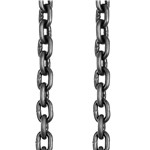19mm Grade 100 2-Leg Chainsling
Chain diameter is 19mm
Grade 100 offers a 25% greater lifting capacity for the same size G80 chain
Lengths available: 2mtr to 6mtr B to B (bearing point to bearing point) - custom chains can be made to order, please contact us for details
Fitted with Self Locking Hook which automatically locks the latch once a load is applied giving extra safety
The latch system is also much stronger than a normal pressed steel latch
Suppied with shortening length adjusters on Chains 2mtr and above as standard
WLL 20 Tonne [Working Load Limit]
Temperature Ranges From -40 TO +200 Degrees C Without Any Reduction In WLL.
 |  |  |
G80 Short Link Chain | G80 Alloy Acessory | G80 Chain Sling |
 |  |  |
| G100 Short Link Chain | G100 Alloy Acessory | G100 Chain Sling |
Do not exceed rating capacity! To be used for industrial lifting only!
Note: When chain is choked it is de-rated 20%
Contact: Ms. Grace
Phone: +86-13867181984
Tel: +86-571-83733296
Email: sales@galifting.com
Add: Office: 9/F No. 2 Mingcheng Building, Xiaoshan Hangzhou China, 311200